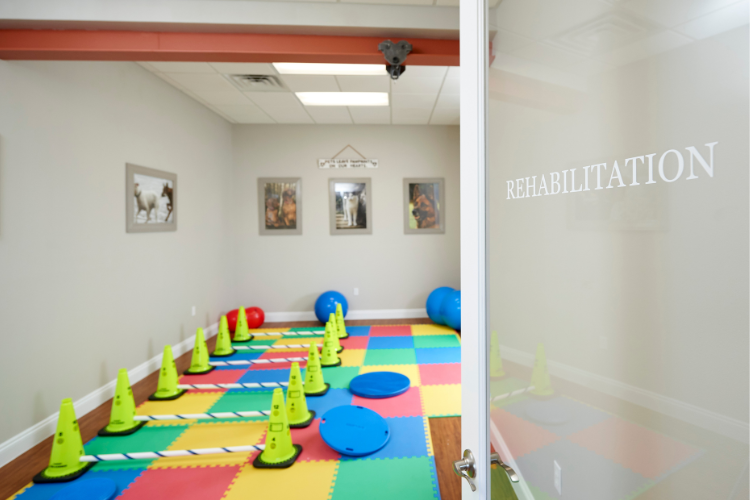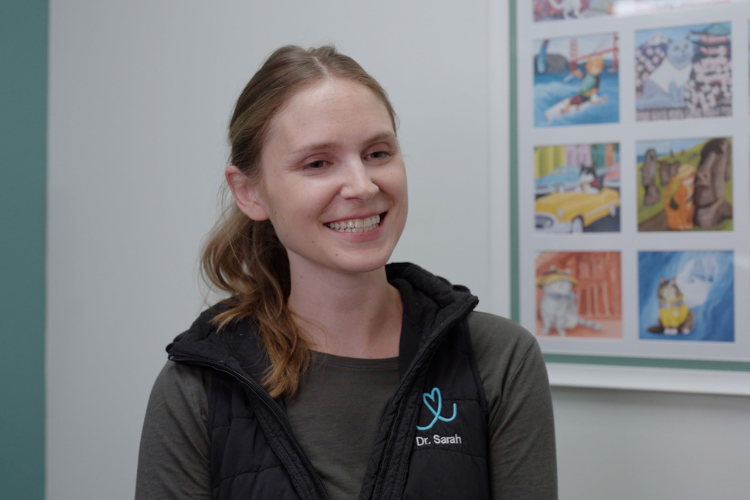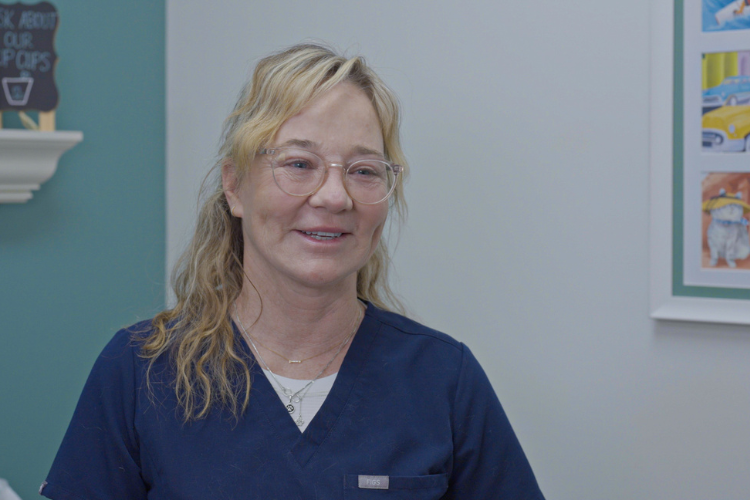
Physical Rehabilitation Therapy and the Role Owners Play with Supplementation
By Lauryn Harker, CCRP, RVT, CAPM & Tiffany Downing, RVT
Canine Rehabilitation of Orange County
Nearly every patient evaluated at Canine Rehabilitation of Orange County suffers from, or is at high risk of developing, joint disease. Young, old, and everything in between, many Physical Rehabilitation patients directly contend with osteoarthritis, orthopedic injuries, and orthopedic surgeries, but less obvious are the patients presenting with joint disease as a compensatory condition.
Neurological patients frequently favor limbs resulting in overloading of non-affected limbs followed by changes to orthopedic tissues. Limb amputee patients post-surgically abruptly displace body weight to remaining limbs resulting in increased workload, requiring additional care. Given that so many patients face pain and reduced mobility associated with joint diseases, Veterinary Physical Rehabilitation aims to maintain comfort and independent mobility using a multi-modal approach.
Getting clients involved in their pet’s recovery is vital for the patient’s optimal outcome. In addition to prescribed in-clinic Rehabilitative Therapy, pet parents are sent home with recommended environmental modifications, nursing care strategies, prescribed at-home activities, and nutritional advice. This frequently includes the addition of joint supplements as part of a cohesive treatment plan. Something as simple as giving a daily joint supplement is an easy way for owners to feel good that they’re participating in their pet’s health care, while also assisting the patient in their goals to regain or maintain comfort and mobility.
Not all supplements are created equal and with the endless amounts of products on the market, it’s important for clients to have access to products that are effective and safe. Even the best store-bought products are at risk of improper shipping or storage conditions prior to purchase, rendering them minimally effective at best. For this reason, it is highly recommended to use products purchased through the patient’s primary care Veterinarian.
Luna’s story
Client compliance with Treatment Plans for patients like Luna, a very picky 11-year-old spayed female German Shepherd who contends with bilateral Hip Dysplasia and compensatory thoracic limb overloading, can be significantly impacted by palatability of recommended medications or supplements. Luna’s owner was saddened and frustrated to report that Luna has vehemently refused nearly every medication, supplement, and treat offered to her.A trial of Rejensa® joint care chews was initiated and three weeks into her treatment plan Luna happily accepts every daily dose. Luna was prescribed twice weekly in-clinic therapy sessions including Photobiomodulation, Hydrotherapy using an Underwater Treadmill, and exercises aimed at improving her peripheral musculature and core strength.
After five weeks of therapy, prescribed at-home exercises, and Rejensa, Luna has resumed stair-climbing and normal walks around the neighborhood.
Dexter’s story
A long-term patient, Dexter, an active 9-year-old neutered male Miniature Dachshund with Intervertebral Disc Disease and a history of three separate spinal surgeries, has been on Rejensa consistently for the last two years. Dexter has participated in once to twice-weekly Physical Rehabilitation Therapy for 4 years over which time he's had occasional back pain, usually after too much activity at home or jumping off furniture. Customizing each of his therapy sessions to his presenting needs has been successful in managing his pain and maintaining mobility.Recently, a decline in comfort was noted and in speaking with Dexter's owner, it was revealed that the owner had run out of Rejensa and Dexter had been without supplementation for several months. After a month of resuming daily Rejensa, the owner shared that “Dexter has gone back to his normal, playful self. He had slowed down a bit recently and wasn’t playing with his brother as much. I thought he was just getting old, and it was to be expected. At CROC’s recommendation, I put him back on Rejensa and was surprised to see such a difference only a few weeks in.”
Dexter’s story perfectly illustrates that the combination of customized Physical Rehabilitation Therapy and clinically proven Rejensa can make an easily observable difference in patient outcomes.
Clark’s story
Clark, an 8-year-old neutered male Husky/Bully breed mix with bilateral chronic partially torn Cranial Cruciate Ligaments presented for a Physical Rehabilitation evaluation. On initial evaluation, bilateral elbow, and stifle crepitus with periarticular thickening of the stifles, atrophy of the pelvic limbs, and palpable spinal pain was also noted. He exhibited a shuffling pelvic limb gait and reduced range of motion at the coxofemoral joints and stifles.Clark was prescribed twice weekly in-clinic therapy sessions, daily prescribed exercises at home, and daily joint supplementation. The owner started Clark on Rejensa and 5 weeks into this treatment plan, Clark was re-evaluated. His range of motion in all limbs had improved considerably along with his gait, spinal pain was no longer apparent upon palpation, and he had gained 1cm of muscle girth in each thigh.
Clark’s dad had this to say about his experience: “I’ve had big dogs before and they always seemed to slow down around Clark’s age. My last dog lost the ability to walk out to the yard to potty and he was too big to carry. Clark started having trouble getting out of his bed in the morning and took a long time to get around the house until later in the day. I even had to start helping him get up from bed. I had to see if there was anything else I could try so I could keep Clark around longer. I had my reservations but gave CROC’s advice a shot just hoping that maybe Clark would get a little better. I brought Clark to all of his therapy appointments, did my best to do his homework exercises every day, and gave him his Rejensa joint supplement every morning. He got a lot better! I don’t have to help him out of bed anymore. In fact, he’s started laying on his back with his legs in the air like he did when he was younger and he’s back to chasing lizards around the yard. It’s like I got my best friend back!”
We strive to stay up to date on the most current effective treatments for our patients by sticking to scientifically backed therapies and clinically proven products. Along with consistent in-clinic therapy and prescribed home activities, Luna, Dexter, and Clark have already benefited notably from Rejensa® joint care chews as part of their daily routine. Their families have reported increased satisfaction from being active participants in their pets’ recovery, feeling that their contributions matter and have even fortified the bond with their pets.
Cohesive use of therapy, supplements, and diet can mean all the difference for our patients’ overall quality of life and longevity. We owe it to them and their families to recommend the best of all three!
Share
Related blogs

Behavior Meds and the Generic Gamble
In her new webinar, Dr. Lisa Radosta I uses real cases to illustrate how behavioral medications function in the real world—and how generics versus brand names, inactive ingredients, and pharmacokinetics (PK) can transform success into setbacks and back again. Learn more, and watch for free, in this blog!

Joint Wellness and OA in Dogs
Dr. Sarah Lochner shares how she assesses where her patients are at on a spectrum of joint health issues, and how she subsequently determines the right mix of supplements, surgery, and therapy options to best protect pet joints now and as they age.

5 Questions a Doctor (and Former Runner) Asks About Mobility
As part of our observation of Wellness Month this March, Dr. Sharon Golden of Golden Veterinary Care shares the top questions she covers in every conversation with pet owners. These behavioral questions are meant to assess a pet's orthopedic issues and needs.